Integration of postpartum healthcare services for HIV-infected women and their infants in South Africa: A randomised controlled trial
In a randomised controlled trial, Landon Myer and colleagues study the effect of an integrated maternal and child health intervention on provision of HIV care.
Published in the journal:
. PLoS Med 15(3): e32767. doi:10.1371/journal.pmed.1002547
Category:
Research Article
doi:
https://doi.org/10.1371/journal.pmed.1002547
Summary
In a randomised controlled trial, Landon Myer and colleagues study the effect of an integrated maternal and child health intervention on provision of HIV care.
Introduction
The past decade has witnessed a paradigm shift in the science of and services for prevention of mother-to-child HIV transmission (PMTCT) [1,2]. Lifelong triple-drug antiretroviral therapy (ART) for all women living with HIV regardless of disease status (per the World Health Organization’s Option B+ approach) has emerged as the standard for reducing vertical HIV transmission and promoting maternal health [3]. With this approach, there have been substantial increases globally in ART use by HIV+ pregnant and postpartum women, with consequent reductions in new paediatric HIV infections, providing a potent example of the synergies of ART use for HIV treatment and prevention [4].
Alongside the successes of universal ART for pregnant and postpartum women, multiple studies from around the world have raised major concerns regarding low levels of retention in HIV services and adherence to ART medications in this population [5–8]. These findings appear especially marked in the postpartum period and contribute directly to failures in maintaining viral suppression (VS) [8,9]. This limits the benefits of ART, and, in turn, there is an urgent need to help HIV+ women to remain engaged in ART services over the long term. Moreover, with new WHO guidelines recommending that HIV+ mothers breastfeed for at least 12 months postpartum [10], the ability of health services to support mothers on ART has direct implications for the health of their HIV-exposed infants. Yet there have been few rigorous evaluations of interventions to promote postpartum engagement in ART services, and existing evaluations have been limited in their duration of follow-up [11].
Related to this, there has been a call for integrating HIV care and treatment services into the broader platform of primary healthcare, particularly in the context of PMTCT [12]. Integration of ART into antenatal care (ANC) services has proven critical to the successful delivery of ART to pregnant women under Option B+ across sub-Saharan Africa [13]. However, there has been little consideration given to the integration of health services during the postpartum period, when HIV+ women’s retention and adherence may be under greatest threat. In many settings, women initiating ART as part of ANC are referred immediately post-delivery to general adult ART services [14,15]. This change in the location of care and the separation of maternal and infant services has been a point of loss to follow-up, and there may be a major missed opportunity for linking ART services within the broader maternal and child health (MCH) care platform. To address this gap, we examined the impact of integrating postpartum ART for HIV+ mothers and infant follow-up within MCH services on maternal retention in care and VS through 12 months postpartum in Cape Town, South Africa.
Methods
Design and setting
We conducted a parallel-arm randomised trial comparing an integrated postnatal care service within the MCH setting for HIV+ mothers and their infants (the MCH-ART intervention) to the local standard of care (SOC, control)—immediate postnatal referral of HIV+ women on ART to general adult ART services and their infants to routine infant follow-up. The trial took place in a subdistrict of Cape Town as described previously [16]. Within the subdistrict, the study was based at a large, primary-level antenatal and obstetric facility located in a community of approximately 300,000 where levels of both poverty and HIV infection are high; referral was to one of a number of primary care services in the subdistrict [17]. The study was registered on ClinicalTrials.gov (NCT01933477); final registration was approved 3 months after the start of enrolment due to an administrative error. The study protocol is provided as S1 Text. The study protocol was approved by the Human Research Ethics Committee of the University of Cape Town Faculty of Health Sciences, as well as by the Institutional Review Board of Columbia University Medical Center.
Routine PMTCT and ART services
In this setting, routine ANC is provided in the MCH clinic and includes PMTCT services with nurse-midwives initiating women on ART and providing follow-up with support from counsellors. ART eligibility is based on local public sector guidelines. For women making their first ANC visit before July 2013, eligibility was based on CD4 cell count ≤ 350 cells/μl or WHO stage III/IV disease, per WHO 2010 recommendation Option A. From July 2013, all HIV+ pregnant women were ART eligible (WHO 2013 recommendation Option B+) [18]. All women initiated the local first-line ART regimen of tenofovir (300 mg) + emtricitabine (200 mg)/lamivudine (300 mg) + efavirenz (600 mg) provided as a fixed-dose combination pill taken once daily. For all women in the study, ART initiation, all clinical care, and infant follow-up was provided by government health services based on public sector policies. Routine infant HIV diagnostic testing in this setting, based on nucleic acid amplification tests, was carried out at 6–10 weeks of age.
Participants and eligibility
Participants were HIV+ women and their infants (regardless of HIV infection status) recruited immediately postpartum during routine clinical follow-up visits. As part of a larger implementation science study, all HIV+ women seeking ANC who were eligible for enrolment were interviewed and followed from their first ANC visit. To be eligible for the trial, women were required to be at least 18 years of age and less than 6 weeks postpartum, to have initiated ART during the recently completed pregnancy (regardless of previous antiretroviral [ARV] exposure or evidence of VS), and to be breastfeeding their infants at the time of screening.
Randomisation
After providing written informed consent, eligible mother–infant pairs were allocated 1:1 to the intervention or control arm via computer-generated block randomisation with dynamically permuted block sizes from 2 to 8. Allocations were via opaque sealed envelopes kept securely and accessed by the study coordinator. The study coordinator communicated the random allocation to nurse-midwives in the MCH clinic via a standardised letter.
MCH-ART intervention
Women randomised to the intervention continued to receive postnatal care in the MCH clinic for the duration of breastfeeding, with care provided to their HIV-exposed infants in the same service. As part of this, nurse-midwives provided ongoing HIV-specific services (including ART and routine infant HIV diagnostic testing) in addition to general care (including contraception for mothers and routine infant care such as anthropometry and vaccinations). At each postnatal visit, nurse-midwives asked mothers about their infant feeding; when mothers reported having stopped breastfeeding, nurse-midwives conducted additional infant HIV diagnostic testing per local guidelines and referred mother–infant pairs out of the MCH clinic, although study-specific follow-up persisted regardless of the site of care.
SOC control
Women and their infants randomised to the control arm followed the local SOC, with referral out of the MCH clinic—to general adult ART services for the mother and “well baby” (child health) services for the infant—by nurse-midwives as soon as possible postpartum, typically at their first postnatal visit.
Referrals
For both the intervention and control arms, referrals out of the MCH clinic followed routine local practice. Women were counselled on ART adherence, infant feeding and care including HIV testing, and related aspects of maternal and infant health. They were provided with a referral letter to attend the ART clinic of their choosing (typically based on area of residence) and dispensed a 1-month supply of ART. Mothers were advised to take infants as soon as possible to their nearest routine child health services, which incorporated care for HIV-exposed infants.
Counselling and patient support
Under both the intervention and control conditions, ART counselling was provided by the routine public sector ART counsellors based either in the MCH clinic (intervention) or general adult ART services (control). These counsellors undergo standardised training and supervision; throughout the study, counselling messages and frequency were based on local standards without adaptation in either the intervention or control arm.
Missed clinic visits
Procedures for tracing women who did not attend a scheduled clinic appointment in either the intervention or control arm were based on local public sector norms: as feasible according to available information and clinic workloads, clinic personnel attempted to contact patients who missed a clinic visit via telephone and/or home visit.
Sources of data
Evaluation data were collected through a series of trial measurement visits scheduled and located separately from the public sector healthcare services involved in either arm of the trial. Visits took place at 6 weeks and then 3, 6, 9, and 12 months postpartum. For attendance at each trial measurement visit, women received R 150 (approximately US$12) in a combination of food vouchers and/or child-related consumables (such as diapers or clothing); no reimbursement was provided for attendance at routine healthcare visits in either the intervention or control arm.
At the start of each measurement visit, participating mothers were instructed to not disclose to study personnel where they were receiving HIV care, and questionnaires did not investigate this. Mothers provided 5 ml of venous blood at each study visit for batched HIV RNA viral load (VL) testing by the South African National Health Laboratory Services (NHLS) using the Abbott RealTime HIV-1 assay (Abbott Laboratories, Abbott Park, Illinois, US); this testing was conducted independently from routine VL monitoring for patients on ART. At the 12-month study visit, infants underwent phlebotomy for HIV PCR testing at NHLS using the Roche COBAS AmpliPrep/COBAS TaqMan HIV-1 assay (Roche Diagnostics, Branchburg, New Jersey, US). In the event of missed trial measurement visits, participants were traced by a study fieldworker working independently of routine healthcare services.
Additional data on maternal and infant use of healthcare services were drawn from routinely collected public sector medical records, abstracted for all participants at the end of the study period. Data sources for this were identical across facilities involved in both arms of the trial and included medical record review at all care facilities (both from folders and electronic medical records, when available, and including infants’ Road to Health Booklets), provincial electronic pharmacy dispensing records, and centralised NHLS databases of laboratory tests.
Outcomes
The primary trial outcome was a composite endpoint of women’s retention in ART care and VS (VL < 50 copies/ml based on VL testing at trial measurement visit) at 12 months postpartum. Retention in care at 12 months postpartum was measured using routinely collected medical records and defined as evidence of an HIV-related clinical contact from the period 9–18 months postpartum. Data used to define a clinical contact came from routinely collected records of ARV dispensing, HIV-related laboratory testing, and clinical care visits. In sensitivity analyses, we examined (i) alternate window periods used to define 12-month retention and (ii) whether the source of retention data influenced trial findings. Secondary outcomes included the separate components of the primary outcome, time to loss of VS, duration of any breastfeeding and exclusive breastfeeding (EBF), infant engagement in appropriate care including HIV testing and use of ARV prophylaxis, maternal family planning use, mother-to-child HIV transmission, and infant mortality. Because outcome data on retention in ART care came from medical records and did not require separate study follow-up, this outcome was available for all participants (regardless of completion of trial measurement visits and availability of VL outcome data) and is presented for all women enrolled as well as restricted to women who also had VL outcome data.
Statistical analysis
The trial sample size was based on a superiority comparison using 90% power and a 2-sided alpha at 0.05. With 1:1 randomisation, we aimed to detect an absolute difference in the primary outcome between trial arms of at least 15%, based on an estimated 90% and 75% of women retained in care and virally suppressed in the MCH-ART and SOC arms, respectively. With an estimated 20% loss to follow-up from the trial by 12 months postpartum, we calculated that approximately 390 women would need to be randomised. When local PMTCT policies changed from Option A to Option B+ in July 2013, we revised the target sample size to be based on 390 women initiating ART under Option B+ but continued to follow up women enrolled in the trial who initiated ART under Option A.
Analyses used Stata version 13.0 (StataCorp, College Station, Texas, US) and R (R Foundation for Statistical Computing, Vienna, Austria). Throughout, results are presented both for all women enrolled and those initiating ART under Option B+; because findings did not differ between these two groups, we focus primarily on the total randomised population. Unless otherwise specified, all analyses are by intention to treat. Variables were described using means (with standard deviations), medians (with interquartile ranges), and proportions (with 95% confidence intervals). We used rank-sum and chi-squared (replaced in the case of sparse data by Fisher’s exact) tests for bivariate analyses; all statistical tests are 2-sided at α = 0.05. Product-limit methods were used for time-to-event analyses, with the log-rank test used to compare survival times. VS was defined as VL < 50 copies/ml for the primary outcome, with additional analyses for VL < 1,000 copies/ml based on international guidelines. Additive binomial regression models [19] were used to examine the effect of trial arm on the primary outcome after adjusting for participant clinical and demographic characteristics; results are presented as absolute risk differences with 95% CIs. Covariates for consideration in these models were selected based on a priori plausibility in predicting either component of the composite endpoint, while not being plausible causal intermediates of any intervention effect; we included in the final model those covariates whose inclusion altered the association of interest (the main trial effect) or which appeared independently associated with the outcome. To examine the potential influence of missing VL outcome data, multiple imputation via chained equations was used to create 25 datasets with complete composite endpoint data for use in sensitivity analyses [20]. Estimates and CIs for imputed data analyses were pooled using Rubin’s rules [21].
Results
Between 5 June 2013 and 10 December 2014, a total of 587 women were screened postpartum for inclusion in the trial, of whom 471 were enrolled and randomised (Fig 1). The main reasons for ineligibility of postpartum mother–infant pairs were the mother’s decision not to breastfeed (13%) or presentation outside the 6-week eligibility window (4%); 8 refusals were noted (1%). Of the 471 breastfeeding mother–infant pairs randomised into the trial at a median of 5 days postpartum (IQR, 4–7), 381 (81%) initiated ART under Option B+.
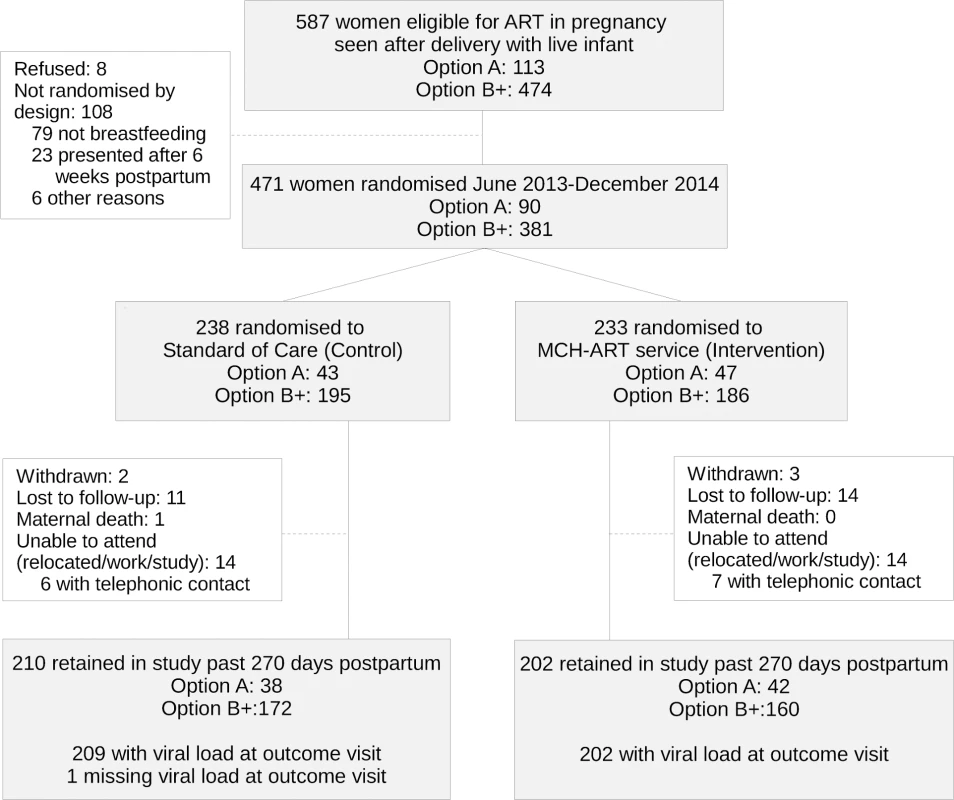
Characteristics at randomisation
Table 1 shows pre-ART and immediate postpartum characteristics by allocation of women to trial arms, overall and restricted to women enrolled under Option B+. At the first ANC visit, the mean age was 28.6 years, 18% of women (n = 87) were nulliparous, and the median gestational age at the start of ANC was 21 weeks (IQR, 16–27). The median CD4 cell count was 354 cells/μl (IQR, 248–517), and the median log10 VL was 4.0 copies/ml (IQR, 3.4–4.6). At the time of randomisation, women had been on ART for a median duration of 18 weeks (IQR, 12–23), 76% (n = 355) were suppressed to VL < 50 copies/ml, and 6% of women (n = 29) had VL ≥ 1,000 copies/ml. By design, 100% of women were breastfeeding at randomisation, and 91% (n = 430) reported EBF.
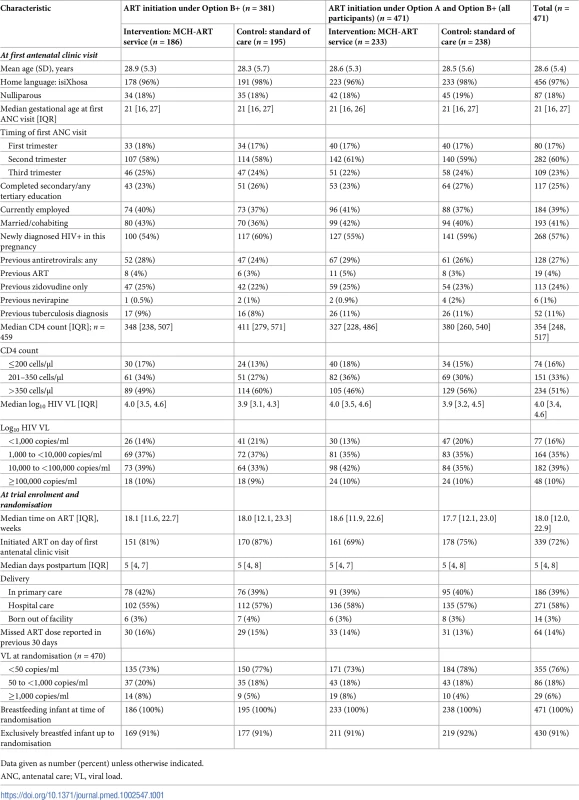
Referral out of the MCH service
Fig 2 shows the distribution of time to referral out of the MCH service in the SOC versus MCH-ART arm. Among the 238 postpartum women (51%) allocated to be referred out of the MCH clinic immediately per SOC, the median time to referral out was 11 days (IQR, 1–21), and 90% of women were referred out within 30 days of delivery to 1 of 18 ART clinics. Women allocated to the intervention MCH-ART arm were retained in the MCH service until a median of 32 (IQR, 10–51) weeks postpartum.
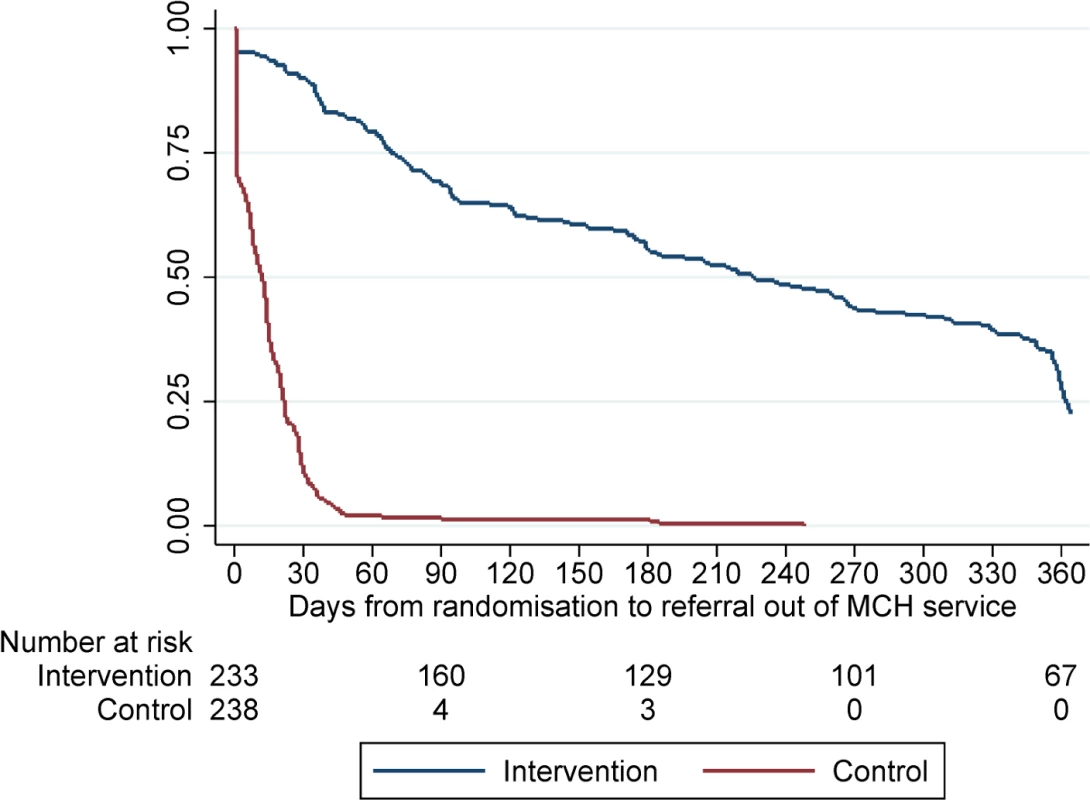
Follow-up in trial measurement visits
All women participating in the trial, regardless of trial arm, were followed with separate trial measurement visits up to 12 months postpartum through 21 January 2016. During this time, 59 women (13%) were lost from scheduled trial measurement visits (independent of their retention in routine HIV care), including 5 women who withdrew (1%) and 1 maternal death (<1%). Of the 412 women who completed the study outcome visit, 1 woman was missing VL measurement, and thus 411 women were available for the primary outcome (87% of those randomised; Fig 1). There was no difference in the completion of trial follow-up and availability of VL outcome data by trial arm or PMTCT option, but on average women who completed the 12-month trial measurement visit were older, were less likely to be diagnosed with HIV during their most recent pregnancy, and entered ANC at an earlier gestational age, compared to women lost from scheduled trial measurement visits (S1 Table). The median duration of ART use at the time of outcome assessment was 15.9 months (IQR, 14.5–17.3; median, 16.1 and 15.9 months in the intervention and control arms, respectively).
Primary outcome
Table 2 compares the primary outcome overall and in its constituents between the trial arms, and shows almost identical results in the Option B+ population and the total trial population. Among the 411 women in the total trial population who completed trial follow-up and had VL data available, 77% of women (n = 155) randomised to the MCH-ART arm achieved the primary composite outcome of retention in ART services with VL < 50 copies/ml at 12 months postpartum, compared to 56% (n = 117) of women randomised to the SOC arm (risk difference, 0.21; 95% CI: 0.12–0.30; risk ratio, 1.37; 95% CI: 1.19–1.58; p < 0.001). Within this composite outcome, 80% of women (n = 330) had evidence of retention in ART services at 12 months postpartum: 88% (n = 178) in the MCH-ART arm and 72% (n = 151) in the SOC arm (p < 0.001). When the analytic population for the retention outcome was extended to all 471 women randomised (regardless of the availability of VL data), these proportions were 81% and 71%, respectively (p = 0.013). The observed differences between the MCH-ART and SOC arms persisted, for both retention in care and VS, under various definitions of these outcomes. For example, 80% of women (n = 162) in the MCH-ART arm and 68% (n = 142) in the SOC arm had VL < 1,000 copies/ml at the study outcome visit (p = 0.005), and the median times to VL ≥ 50 and VL ≥ 1,000 copies/ml, among those with VL < 50 copies/ml at randomisation, were significantly longer among women in the MCH-ART arm compared to women in the SOC arm (S1 and S2 Figs). Moreover, the findings related to retention did not differ appreciably by the data source or window period used to define retention (Tables 2 and S2).
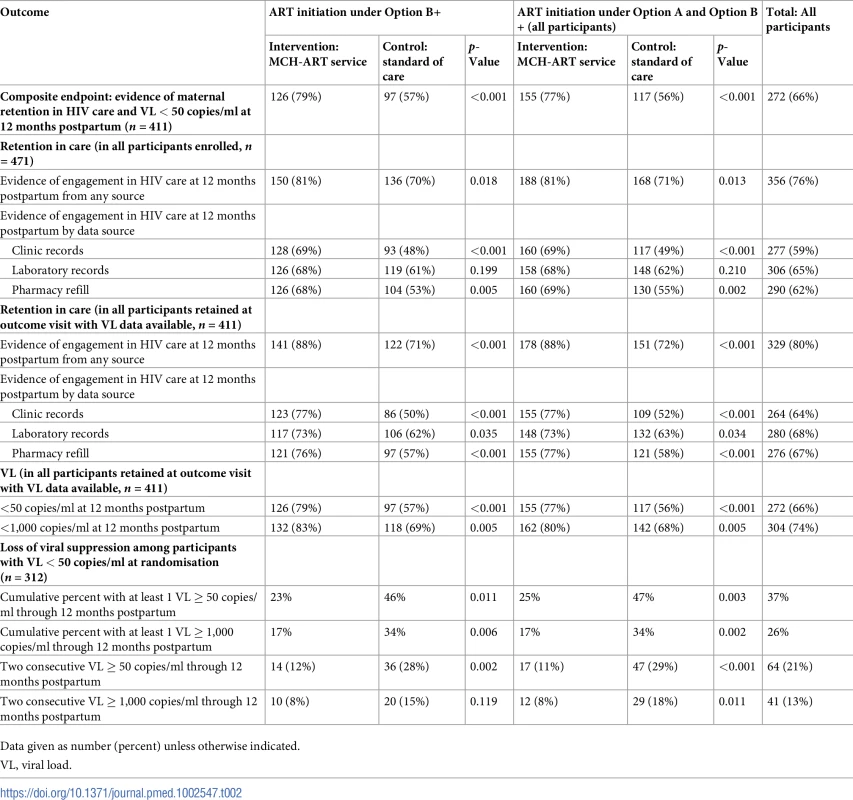
The overall findings for superior retention in care and virologic outcomes among women in the MCH-ART arm appeared consistent across subgroups of participants according to demographic and clinical characteristics (Figs 3, S3 and S4). Of note, the strongest intervention effects were observed in women initiating ART during the third trimester of pregnancy (risk difference, intervention minus control, 42%) compared to the second and first trimesters (risk differences, 16% and 4%, respectively). In a multivariable model (Table 3), the overall difference in the primary outcome between intervention and control persisted. In addition, ART initiation later in pregnancy, previous diagnosis with tuberculosis infection, and increased VL at the time of randomisation were associated with decreased VS and/or retention postpartum. In a secondary analysis with missing VL outcome data imputed, the observed differences between the intervention and control arms persisted (S3 Table).
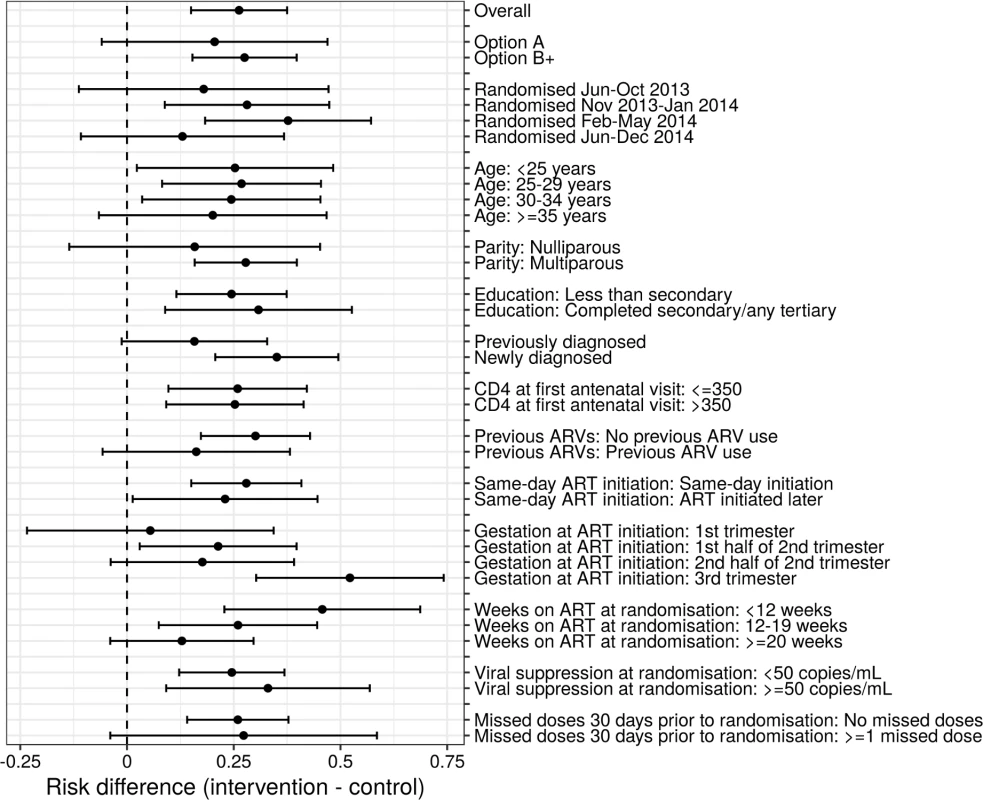
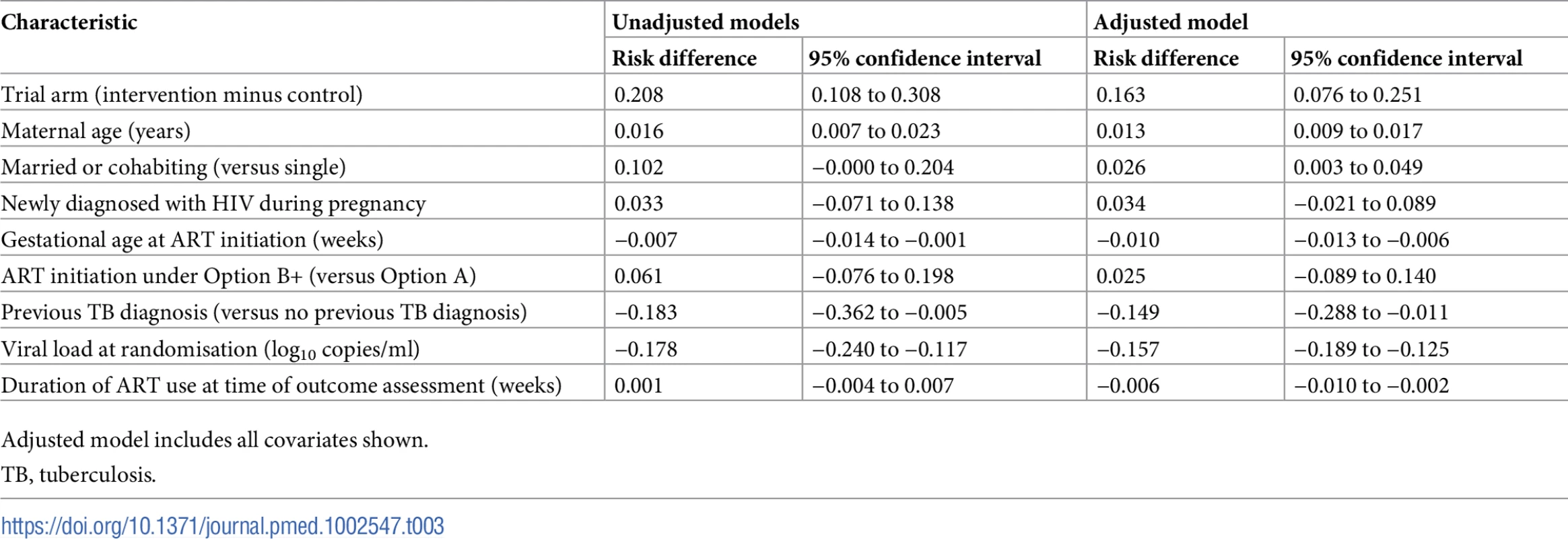
Effect of duration of MCH-ART service
S4 Table compares outcomes among women randomised to the intervention who were retained in the MCH-ART service for different durations postpartum. Women randomised to the intervention who stopped breastfeeding and were referred out within 3 months postpartum had VL and ART retention outcomes measured at 12 months postpartum that were similar to those of women randomised to the control arm. Conversely, women who breastfed and were retained for longer periods in the MCH-ART service experienced improvements in outcomes measured at 12 months postpartum in a graded manner, with the largest intervention effects observed in women retained for at least 9 months postpartum; this trend persisted after adjusting for demographic and clinical covariates (S5 Table). Among women in the intervention arm, each additional month spent in the integrated MCH-ART service was associated with a 2.5% increase (95% CI: 1.9%–3.1%) in the absolute risk of being retained in care and virally suppressed at 12 months postpartum in adjusted models.
Secondary outcomes
Patterns of breastfeeding during the study differed between women randomised to the intervention and control arms (Figs 4 and 5). The median duration of any breastfeeding was longer among women randomised to the MCH-ART arm than among those randomised to the SOC arm in the total trial population (6.9 versus 3.0 months; p = 0.006) and when restricted to women initiating ART under Option B+ (6.0 versus 3.0 months; p = 0.023). By 12 months postpartum, 16% in the MCH-ART arm and 12% in the SOC arm reported still breastfeeding in the total trial population. The duration of EBF was shorter but followed a similar pattern, with a median of 3.0 months in the MCH-ART arm versus 1.4 months in the SOC arm (p < 0.001) in the total trial population.
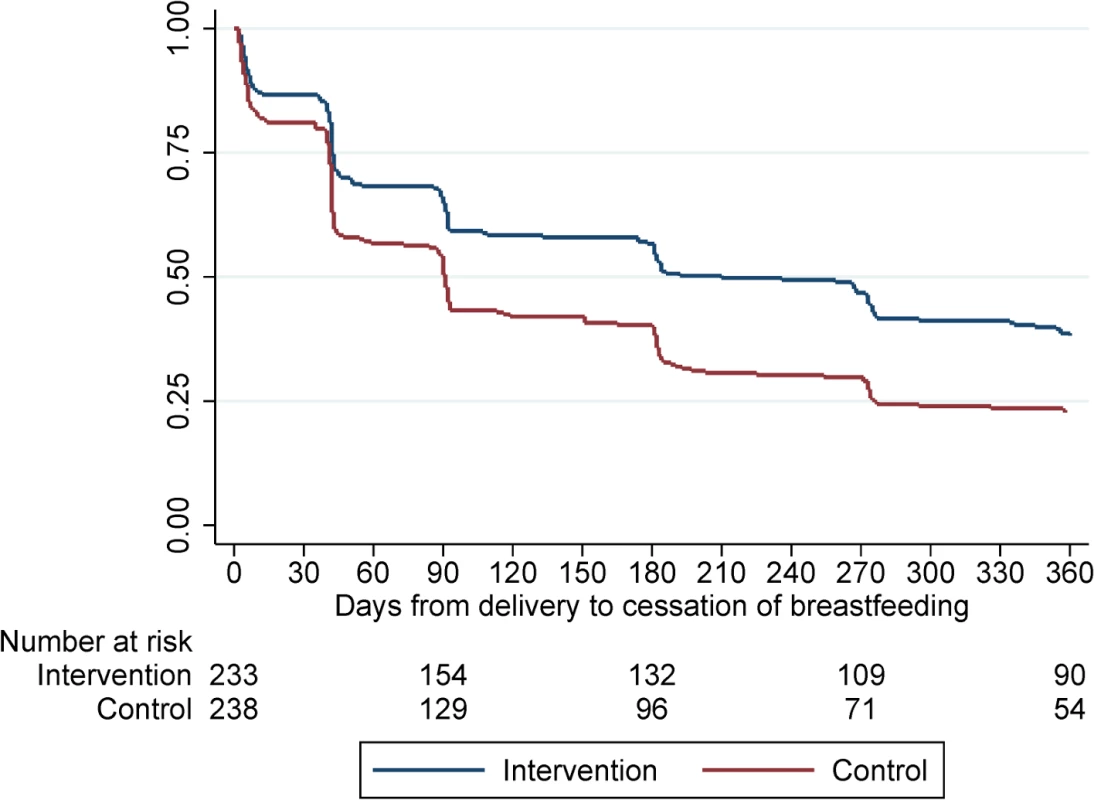
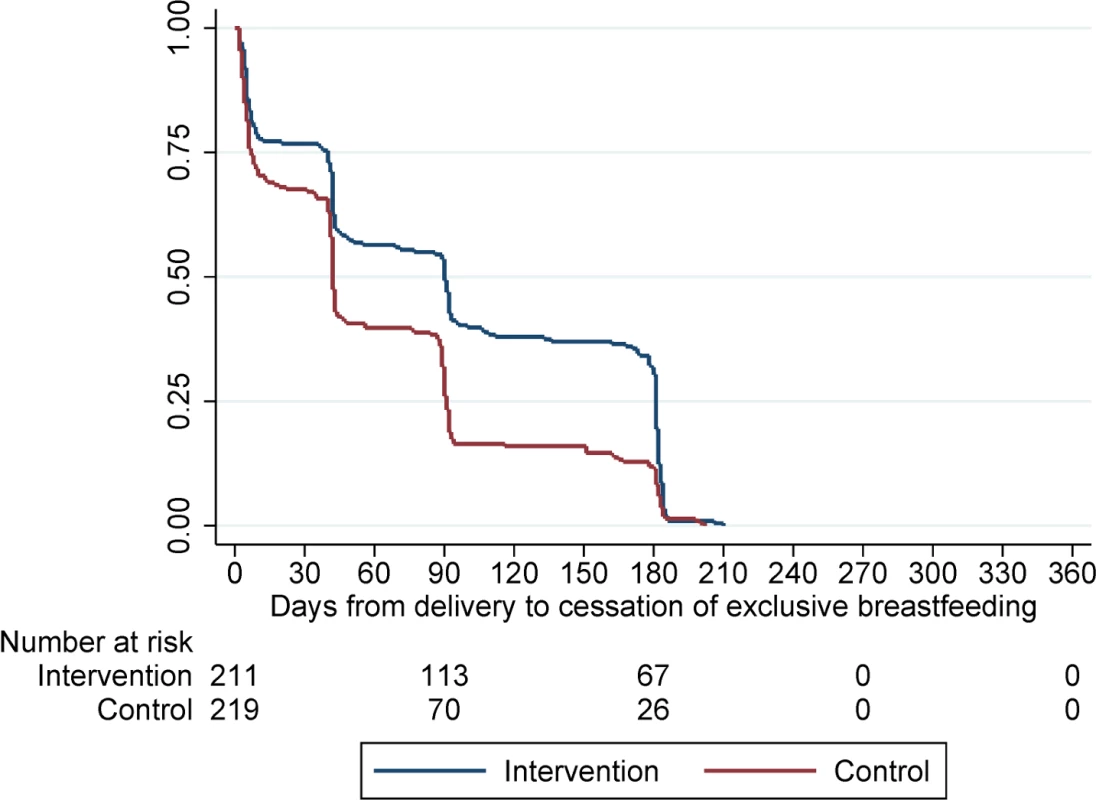
Table 4 compares MCH outcomes between trial arms, which did not differ significantly between the intervention and control arms. Among 478 infants in the study, there were 9 deaths and 5 HIV infections observed in the first 12 months postpartum. Overall HIV-free survival through 12 months of age was 97%: mother-to-child HIV transmission at 12 months was 1.2% overall (comparison by trial arm, p = 0.178), and infant mortality was 1.9% (comparison by trial arm, p = 0.296).
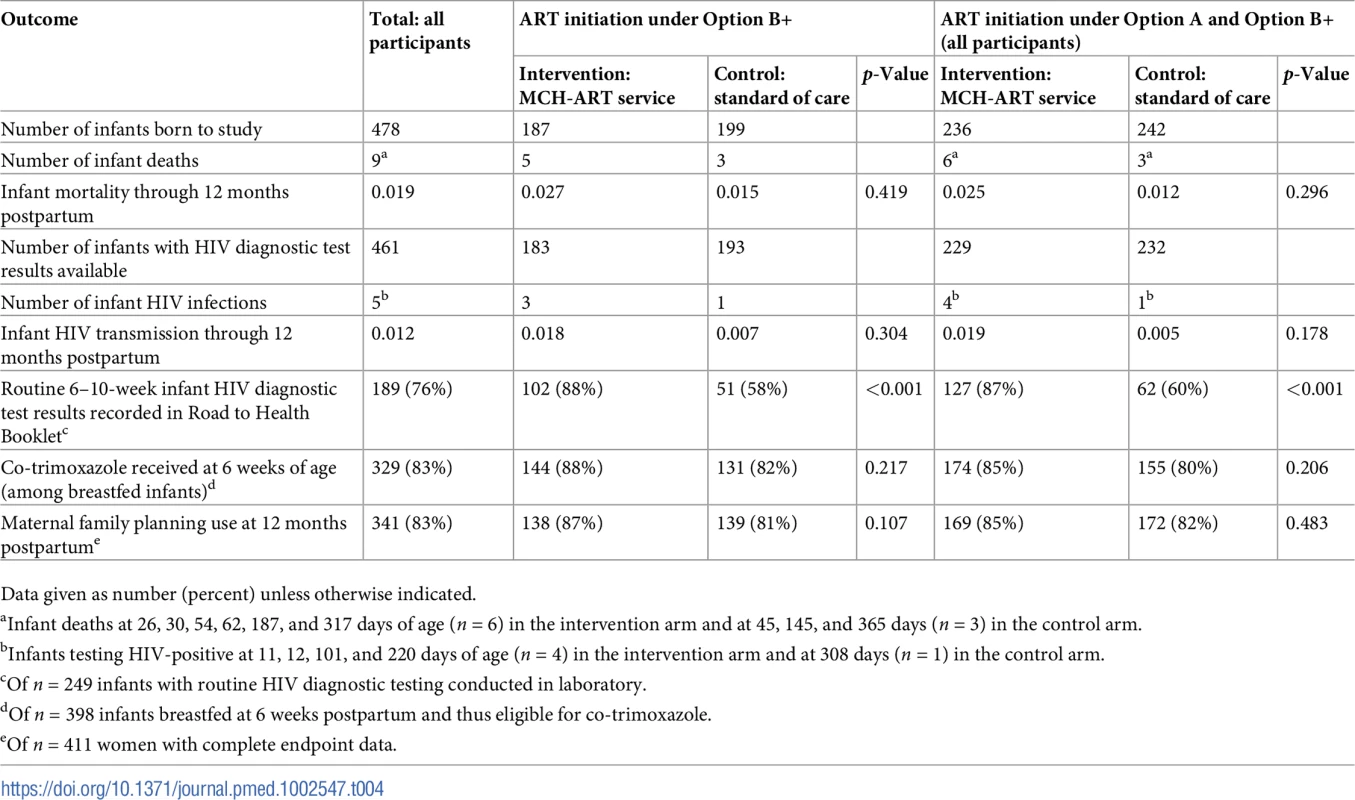
Discussion
This study demonstrates that integration of ART services into the MCH platform can lead to significant improvements in HIV+ women’s retention in care and VS up to 12 months postpartum. We also found longer durations of any BF and EBF among women who were randomised to integrated MCH and ART services. Overall, the integration of MCH and ART services may represent a simple intervention that can enhance the health of HIV+ women and their children in the first year after delivery.
This is one of the few randomised studies presenting evidence that integration of MCH and ART services can enhance women’s engagement in HIV care during the postnatal period and improve biomedical outcomes. While the challenges of retention in care and adherence to ART in HIV+ women during the postnatal period have been widely documented, rigorously evaluated interventions to strengthen women’s engagement in services are scant. Existing intervention modalities typically target individual women as the locus of intervention, for example through intensified patient counselling, mobile health interventions, services offered by lay health workers, and/or incentivising health behaviours, often with mixed results over short durations postpartum [11]. While these approaches may be useful to address single, specific causes of women’s disengagement from care, the intervention effects observed to date have been modest, and the feasibility of scaling up these interventions remains unclear.
In contrast, the integration of services represents a structural health systems intervention that may impact on multiple aspects of service engagement. We observed strong associations involving the primary outcome, women’s retention in care, and VS, as well as infant feeding practices; we had limited power to detect associations with outcomes that occur more commonly (such as maternal family planning use) or rarely (such as mother-to-child HIV transmission) in this setting. While not all research has shown improvements in care associated with integration of HIV and MCH services [22], our results are congruent with previous findings that models of care for postnatal ART services can influence outcomes for HIV+ women and their families. One health services evaluation from Malawi suggested that clinics that combined maternal and infant care yielded superior maternal retention outcomes compared to disaggregated forms of care where mothers received treatment within general adult ART services [14]. Similarly, a randomised controlled trial in Nigeria found significant increases in maternal retention in HIV care up to 3 months postpartum with a multicomponent package intervention that included co-scheduling of care for HIV+ mothers and their infants [23]. Building on these results, our trial findings advance the state of knowledge by providing compelling evidence demonstrating the specific effects of integrated postnatal services on multiple MCH outcomes.
The differences observed in the primary outcome between the intervention and control arms were generally similar across a range of subgroups. Of note, there is considerable interest in the impact of ART initiation on the same day as the first ANC visit, compared to delaying ART initiation to allow time for patient preparation [24]; we found the intervention effect persisted regardless of this timing. Moreover, it is plausible that women who are newly diagnosed with HIV in pregnancy may face particular challenges in ART retention and adherence, though intervention effects were similar regardless of when women were diagnosed with HIV infection. In addition, there are special concerns around the provision of lifelong ART for young pregnant and postpartum women [25], but here the intervention effects were consistent across all age groups.
We found that the strength of the intervention effect varied according to the amount of time postpartum spent in the intervention service in a graded manner: the largest improvements in the primary outcome were observed among women retained in the intervention beyond 9 months postpartum, with smaller but appreciable differences observed in women retained for 3 to 9 months. Meanwhile, among women in the intervention arm referred out to general ART services before 3 months postpartum, outcomes measured at 12 months postpartum were identical to those observed in the control arm. From these findings, we hypothesize that the integrated care intervention may provide a critical foundation for establishing and maintaining positive ART-related behaviours [26]. Related to this, we observed the strongest intervention effects in women who initiated ART later in pregnancy—a high-risk group that warrants special attention [27]. Specifically, women who started ART earlier in pregnancy, and thus spent more time establishing positive ART-related behaviours before delivery, may have benefitted less from remaining engaged in the integrated MCH-ART intervention service for longer durations postpartum. In contrast, women initiating ART later in pregnancy may have experienced greater benefit from the longer durations spent in the integrated service afforded by the intervention.
Alternate explanations for several findings warrant consideration. It is possible that some part of the intervention effect may be attributable to delaying the referral of women out of the MCH setting to adult ART clinics. Women retained in the intervention service after 9 months would have had less opportunity to disengage from care before the outcome visit at 12 months postpartum, though this would not explain the intervention effect observed among women referred out before 9 months. Here, we used 12 months postpartum for the primary outcome as most breastfeeding ends before this time in this setting, but it is critical to note that breastfeeding and mother-to-child transmission risk may be for longer periods, and challenges in maternal non-adherence and non-retention in services extend beyond this window. The transfer of patients between chronic care services is recognised as a high-risk window for non-adherence and non-retention [15,28], and longer durations of follow-up will be required to evaluate whether the effects of the intervention appear in keeping with this hypothesis. In addition, it is possible that differential availability of routine care data across health facilities in this setting could have explained some of the differences observed in retention outcomes between the intervention and control arms. However, we note consistency in the retention findings according to routine data source used, and further consistency with directly measured VS outcomes, making this explanation unlikely.
There are a range of mechanisms that may have contributed to the improved maternal health outcomes associated with the integrated services assessed here. The co-location of maternal and infant care may lower the burden of clinic visits, reducing the time and economic costs of healthcare attendance. For some women, receiving ART in the MCH setting may be associated with less HIV-related stigma compared to general adult ART services, and thus be more acceptable. In addition, nurse-midwives and other MCH providers may maintain better relationships with postpartum women, and in turn be better able to promote positive health behaviours. While these and other mechanisms warrant investigation, we posit that the reasons why integrated services lead to improved health outcomes are likely to be diverse and multifactorial, with different women benefitting from different aspects of integrated care for different reasons.
This study also provides novel evidence that integrated postnatal services are associated with prolonged breastfeeding, including EBF, by HIV+ women. Our finding may be unsurprising given the emphasis on breastfeeding within MCH services, in marked contrast to general adult services, where infant feeding practices may receive less attention [29]. While the relatively short overall duration of breastfeeding in this setting is in keeping with local norms, the trial’s findings of longer breastfeeding and higher levels of VS in women randomised to the MCH-ART intervention suggest that such integrated models of postnatal care may play an important role in implementing new WHO infant breastfeeding policies [21]. Furthermore, we found that the integrated MCH-ART service was associated with higher levels of recording of routine early infant diagnostic testing for HIV; given the challenges in implementing effective infant testing services in many settings [30], this is an important feature that warrants further investigation.
Several strengths and limitations require attention in interpreting these data. The trial took place in primary care public sector services in a single part of South Africa, and as with any health systems intervention, the generalisability of results should be considered with caution. The control condition used here needs particular consideration when seeking to extrapolate these results regarding the effects of integrated services. The SOC here may be broadly representative of how MCH and ART are provided across urban and high-burden areas of South Africa and southern Africa. However, this is not the SOC in all countries, and in different settings there may be other models of delivering integrated postnatal MCH and HIV care to mothers and infants, particularly in smaller primary care facilities. In this light, we suggest that the key findings here are for the value of integrated service delivery approaches for providing care in the postnatal period, rather than suggesting a single, universally ideal model of care. To evaluate the intervention, we used a novel composite primary endpoint incorporating both healthcare utilisation and the key biomarker of interest in HIV treatment, VL, though few interventions in this field have utilised such robust measures. We examined outcomes through 12 months postpartum—among the longest postpartum evaluations to date—but given that ART is lifelong, investigations of extended outcomes for both mothers and children are warranted. Here breastfeeding data were self-reported by mothers, raising ubiquitous concerns around biased reporting [31], though our study visits took place separately from routine care to help minimise such errors. Of note, this intervention does not address the phenomenon of loss to follow-up during pregnancy immediately after ART initiation, which is a separate and important consideration [8,14]. As discussed above, this trial only examines outcomes through 12 months postpartum, and the outcomes of transfers after that period require further investigation. Finally, the acceptability of service integration among patients and providers, as well as costs and cost-effectiveness, are important considerations not addressed in these data, but will be important avenues for future research.
In summary, these findings have substantial implications for policy and programme design. With few previous insights into the integration of HIV care into postnatal MCH settings, this study demonstrates that integrating ART services into the MCH platform for the duration of breastfeeding may be a simple and effective intervention for improving MCH outcomes in the context of HIV.
Supporting Information
Zdroje
1. Luzuriaga K, Mofenson LM. Challenges in the elimination of pediatric HIV-1 infection. N Engl J Med. 2016; 374(8):761–70. doi: 10.1056/NEJMra1505256 26933850
2. Fowler MG, Qin M, Fiscus SA, Currier JS, Flynn PM, Chipato T, et al. Benefits and risks of antiretroviral therapy for perinatal HIV prevention. N Engl J Med. 2016;375(18):1726–37. doi: 10.1056/NEJMoa1511691 27806243
3. World Health Organization. Consolidated guidelines on the use of antiretroviral drugs for treating and preventing HIV infection. 2nd edition. Geneva: World Health Organization; 2016.
4. Joint United Nations Programme on HIV/AIDS. Get on the fast-track: the life-cycle approach to HIV. Geneva: Joint United Nations Programme on HIV/AIDS; 2016.
5. Huntington S, Thorne C, Newell ML, Anderson J, Taylor GP, Pillay D, et al. The risk of viral rebound in the year after delivery in women remaining on antiretroviral therapy. AIDS. 2015;29(17):2269–78. doi: 10.1097/QAD.0000000000000826 26544700
6. Adams JW, Brady KA, Michael YL, Yehia BR, Momplaisir FM. Postpartum engagement in HIV care: an important predictor of long-term retention in care and viral suppression. Clin Infect Dis. 2015;61(12):1880–7. doi: 10.1093/cid/civ678 26265499
7. Nachega JB, Uthman OA, Anderson J, Peltzer K, Wampold S, Cotton MF, et al. Adherence to antiretroviral therapy during and after pregnancy in low-income, middle-income, and high-income countries: a systematic review and meta-analysis. AIDS. 2012;26(16):2039–52. doi: 10.1097/QAD.0b013e328359590f 22951634
8. Haas AD, Tenthani L, Msukwa MT, Tal K, Jahn A, Gadabu OJ, et al. Retention in care during the first 3 years of antiretroviral therapy for women in Malawi’s option B+ programme: an observational cohort study. Lancet HIV. 2016;3(4):e175–82. doi: 10.1016/S2352-3018(16)00008-4 27036993
9. Henegar CE, Westreich DJ, Maskew M, Miller WC, Brookhart MA, Van Rie A. Effect of pregnancy and the postpartum period on adherence to antiretroviral therapy among HIV-infected women established on treatment. J Acquir Immune Defic Syndr. 2015;68(4):477–80. doi: 10.1097/QAI.0000000000000501 25559590
10. World Health Organization. Guidelines update on HIV and infant feeding. Geneva: World Health Organization; 2016.
11. Geldsetzer P, Yapa HM, Vaikath M, Ogbuoji O, Fox MP, Essajee SM, et al. A systematic review of interventions to improve postpartum retention of women in PMTCT and ART care. J Int AIDS Soc. 2016;19(1):20679. doi: 10.7448/IAS.19.1.20679 27118443
12. Suthar AB, Hoos D, Beqiri A, Lorenz-Dehne K, McClure C, Duncombe C. Integrating antiretroviral therapy into antenatal care and maternal and child health settings: a systematic review and meta-analysis. Bull World Health Organ. 2013;91(1):46–56. doi: 10.2471/BLT.12.107003 23397350
13. Kiragu K, Collins L, Von Zinkernagel D, Mushavi A. Integrating PMTCT into maternal, newborn, and child health and related services: experiences from the Global Plan priority countries. J Acquir Immune Defic Syndr. 2017;75(Suppl 1):S36–42.
14. van Lettow M, Bedell R, Mayuni I, Mateyu G, Landes M, Chan AK, et al. Towards elimination of mother-to-child transmission of HIV: performance of different models of care for initiating lifelong antiretroviral therapy for pregnant women in Malawi (Option B+). J Int AIDS Soc. 2014;17:18994. doi: 10.7448/IAS.17.1.18994 25079437
15. Phillips T, McNairy ML, Zerbe A, Myer L, Abrams EJ. Implementation and operational research: postpartum transfer of care among HIV-infected women initiating antiretroviral therapy during pregnancy. J Acquir Immune Defic Syndr. 2015;70(3):e102–9. doi: 10.1097/QAI.0000000000000771 26470033
16. Myer L, Phillips TK, Zerbe A, Ronan A, Hsiao NY, Mellins CA, et al. Optimizing antiretroviral therapy (ART) for maternal and child health (MCH): rationale and design of the MCH-ART study. J Acquir Immune Defic Syndr. 2016;72(Suppl 2):S189–96.
17. Myer L, Phillips T, Manuelli V, McIntyre J, Bekker LG, Abrams EJ. Evolution of antiretroviral therapy services for HIV-infected pregnant women in Cape Town, South Africa. J Acquir Immune Defic Syndr. 2015;69(2):57–65.
18. World Health Organization. Consolidated guidelines on the use of antiretroviral drugs for treating and preventing HIV infection. Geneva: World Health Organization; 2013.
19. Kovalchik SA, Varadhan R, Fetterman B, Poitras NE, Wacholder S, Katki HA. A general binomial regression model to estimate standardized risk differences from binary response data. Stat Med. 2013;32(5):808–21. doi: 10.1002/sim.5553 22865328
20. Van Buuren S, Groothuis-Oudshoorn K. MICE: multivariate imputation by chained equations in R. J Stat Softw. 2011;45(3):1–67.
21. Rubin DB. Multiple imputation for nonresponse in surveys. New York: John Wiley & Sons; 1987.
22. Turan JM, Onono M, Steinfeld RL, Shade SB, Owuor K, Washington S, et al. Implementation and operational research: effects of antenatal care and HIV treatment integration on elements of the PMTCT cascade: results from the SHAIP cluster-randomized controlled trial in Kenya. J Acquir Immune Defic Syndr. 2015;69(5):e172–81. doi: 10.1097/QAI.0000000000000678 25967269
23. Aliyu MH, Blevins M, Audet CM, Kalish M, Gebi UI, Onwujekwe O, et al. Integrated prevention of mother-to-child HIV transmission services, antiretroviral therapy initiation, and maternal and infant retention in care in rural north-central Nigeria: a cluster-randomised controlled trial. Lancet HIV. 2016;3(5):e202–11. doi: 10.1016/S2352-3018(16)00018-7 27126487
24. Chan AK, Kanike E, Bedell R, Mayuni I, Manyera R, Mlotha W, at al. Same day HIV diagnosis and antiretroviral therapy initiation affects retention in Option B+ prevention of mother-to-child transmission services at antenatal care in Zomba District, Malawi. J Int AIDS Soc. 2016;19(1):20672. doi: 10.7448/IAS.19.1.20672 26976377
25. Callahan T, Modi S, Swanson J, Ng’eno B, Broyles LN. Pregnant adolescents living with HIV: what we know, what we need to know, where we need to go. J Int AIDS Soc. 2017;20(1):21858. doi: 10.7448/IAS.20.1.21858 28782334
26. Ford N, Darder M, Spelman T, Maclean E, Mills E, Boulle A. Early adherence to antiretroviral medication as a predictor of long-term HIV virological suppression: five-year follow up of an observational cohort. PLoS ONE. 2010;5(5):e10460. doi: 10.1371/journal.pone.0010460 20485480
27. Simkhada B, Teijlingen ER, Porter M, Simkhada P. Factors affecting the utilization of antenatal care in developing countries: systematic review of the literature. J Adv Nurs. 2008;61(3):244–60. doi: 10.1111/j.1365-2648.2007.04532.x 18197860
28. Cornell M, Lessells R, Fox MP, Garone DB, Giddy J, Fenner L, et al. Mortality among adults transferred and lost to follow-up from antiretroviral therapy programmes in South Africa: a multicenter cohort study. J Acquir Immune Defic Syndr. 2014;67(2):e67–75. doi: 10.1097/QAI.0000000000000269 24977471
29. McFadden A, Gavine A, Renfrew MJ, Wade A, Buchanan P, Taylor JL, et al. Support for healthy breastfeeding mothers with healthy term babies. Cochrane Database Syst Rev. 2017;2:CD001141. doi: 10.1002/14651858.CD001141.pub5 28244064
30. Essajee S, Bhairavabhotla R, Penazzato M, Kiragu K, Jani I, Carmona S, et al. Scale-up of early infant HIV diagnosis and improving access to pediatric HIV care in Global Plan countries: past and future perspectives. J Acquir Immune Defic Syndr. 2017;75(Suppl 1):S51–8.
31. Bland RM, Rollins NC, Solarsh G, Van den Broeck J, Coovadia HM, Child Health Group. Maternal recall of exclusive breastfeeding duration. Arch Dis Child. 2003;88(9):778–83. doi: 10.1136/adc.88.9.778 12937095
Štítky
Interní lékařstvíČlánek vyšel v časopise
PLOS Medicine
2018 Číslo 3
- Berberin: přírodní hypolipidemikum se slibnými výsledky
- Příznivý vliv Armolipidu Plus na hladinu cholesterolu a zánětlivé parametry u pacientů s chronickým subklinickým zánětem
- Hydrofilní gel na bázi medu v terapii chronických a infikovaných ran
- Léčba bolesti u seniorů
- Jakým mýtům o štítné žláze věří naši pacienti?
Nejčtenější v tomto čísle
- Forced anal examinations to ascertain sexual orientation and sexual behavior: An abusive and medically unsound practice
- Polycystic ovary syndrome, androgen excess, and the risk of nonalcoholic fatty liver disease in women: A longitudinal study based on a United Kingdom primary care database
- The current and potential health benefits of the National Health Service Health Check cardiovascular disease prevention programme in England: A microsimulation study
- Cardiovascular disease and multimorbidity: A call for interdisciplinary research and personalized cardiovascular care
